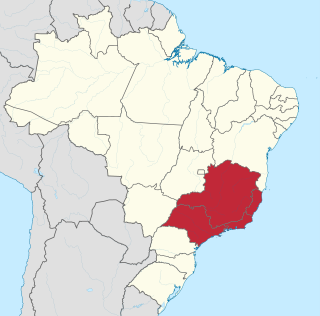São Mateus is Portuguese for Saint Matthew, and may refer to one of the following places:

The Southeast Region of Brazil is composed of the states of Espírito Santo, Minas Gerais, Rio de Janeiro and São Paulo. It is the richest region of the country, responsible for approximately 60% of the Brazilian GDP, as São Paulo, Rio de Janeiro, and Minas Gerais are the three richest states of Brazil, the top three Brazilian states in terms of GDP. The Southeast of Brazil also has the highest GDP per capita among all Brazilian regions.

Vriesea is a genus of flowering plants in the botanical family Bromeliaceae, subfamily Tillandsioideae. The genus name is for Willem Hendrik de Vriese, Dutch botanist, physician (1806–1862). Its species are widespread over Mexico, Central America, South America and the West Indies.

Canistrum is a genus of plants in the family Bromeliaceae, subfamily Bromelioideae.

Dyckia is a genus of plants in the family Bromeliaceae, subfamily Pitcairnioideae.

Stenopadus is a genus of South American plants in the family Asteraceae.

Austroeupatorium is a genus of plants native primarily to South America, including herbaceous perennials and shrubs. The native range is focused on eastern South America and extends as far north as Panama and Trinidad and as far west as Bolivia.
Austrocritonia is a genus of flowering plants in the family Asteraceae.
Campovassouria is a genus of flowering plants in the family Asteraceae.
Dasycondylus is a genus of flowering plants in the family Asteraceae.
Steyermarkina is a genus of South American plants in the tribe Eupatorieae within the family Asteraceae.

Symphyopappus is a genus of South American plants in the tribe Eupatorieae within the family Asteraceae.
Trichogoniopsis is a genus of Brazilian plants in the tribe Eupatorieae within the family Asteraceae.
Graphistylis is a genus of Brazilian flowering plants in the daisy family.
The Brazilian municipal elections of 2012 took place on October 7 and on October 28. Over 138 million voters chose mayors, deputy mayors and city councillors for the 5,568 municipalities of Brazil. These were the first elections in which the recently registered parties Partido Pátria Livre (PPL) and Partido Social Democrático (PSD) participated; they were both recognized by the Superior Electoral Court in 2011. Political parties whose candidates wished to run for the 2012 elections had to be registered at the TSE for at least one year before the election date, while candidates also had to be affiliated to a party for the same period of time. Conventions for the selection of candidates within the parties occurred between 10 and 30 June, while the registry of candidates and alliances with the Regional Electoral Courts took place until July 5. Electoral campaign was authorized from the moment a candidacy had been registered. The free electoral program – two daily slots on free-to-air TV and radio for political advertising paid by the Electoral Justice fund – ran weekdays from 21 August until 4 October. According to the current Brazilian electoral law, the two-round system – should the leading candidate receive less than 50% +1 of the votes – is only available for cities with more than 200,000 voters. This includes all state capitals, with the exception of Boa Vista, Roraima and Palmas, Tocantins, plus 59 other municipalities. The free electoral program for the second round ran from 13 October until 26 October.
This is a list of results for all the matches played from 1951 to 2010 by the São Paulo state football team.
This is a list of results for all the matches played from 1901 to 1950 by the Rio de Janeiro state football team.
Elton Martinez Carvalho Leme is a Brazilian who is employed as a judge. He is also a self-taught botanist with a special interest in bromeliads. As of November 2022, the International Plant Names Index listed 629 scientific names which include Leme as a publishing author, including 13 generic names.







